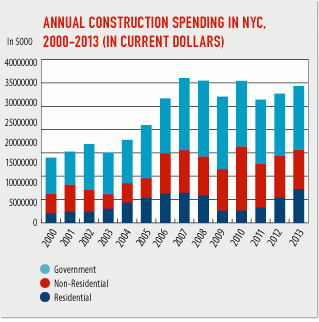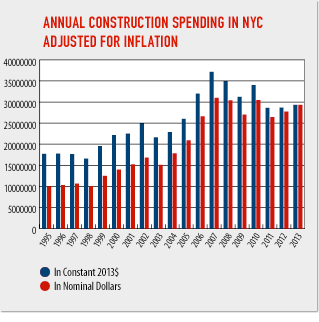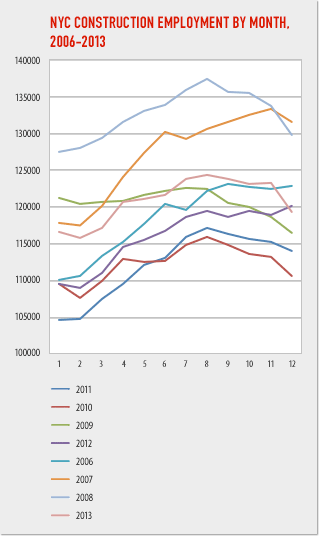
NYC construction spending reached $29.3 billion in 2013; six percent increase spurred by surging residential sector
Construction Activity Yielded $45 Billion in Total Economic Impact for City
Overall construction spending in New York City reached $29.3 billion in 2013, a six percent increase from 2012, when total spending reached $27.7 billion, according to a New York Building Congress analysis.
Construction employment in New York City reached a five year high of 120,900 jobs in 2013, a four percent increase from 2012, when construction accounted for 116,000 jobs. Industry employment, however, remains well short of the 132,625 jobs that were produced in 2008.
Residential
Residential construction spending reached its highest level in decades in 2013, even after factoring for inflation. Total spending in this sector increased 36 percent in 2013 – from $5.3 billion in 2012 to $7.3 billion last year.
Just as importantly, a total of 18,095 new residential units were constructed in 2013, a 64 percent increase from 2012. This is the highest level of dwelling unit production since 2008, when 33,170 units were produced on $5.9 billion in spending.
“The residential sector, which cratered in the immediate aftermath of the recession, continued its remarkable comeback story in 2013,” said New York Building Congress President Richard T. Anderson. “In fact, construction spending in the residential sector was greater last year than it was during the height of the building boom – even after factoring for inflation. The one note of caution, however, is that we are producing less new square footage and far fewer new units of housing today than we did between 2005 and 2008, a period that saw more than 30,000 new units created annually.”
Government
Government construction spending, which includes investments in mass transit, public schools, roads, bridges, and other essential infrastructure, increased slightly from $13.4 billion in 2012 to $13.7 billion in 2013. In all, government construction accounted for 47 percent of New York City construction spending. Government spending peaked at $16.3 billion in 2008, but has remained in the $13-14 billion range over the past three years.
Non-Residential
Non-residential construction, which includes office space, institutional development, sports/entertainment venues, and hotels, fell 6.9 percent – from $9.0 billion in 2012 to $8.4 billion in 2013. This marks the third consecutive year in which non-residential spending has declined from the prior year.
“At $8.4 billion, construction spending in the non-residential sector was substantial in 2013, but it is disappointing to see a decline in annual spending,” noted Mr. Anderson. “It is also disappointing in that we had expected spending in this sector to reach $10 billion when we released our annual forecast in October of last year. Hopefully, much of the anticipated work will come to fruition in the coming year.”
Economic Impact
While construction activity in 2013 directly resulted in 120,900 construction jobs and $29.3 billion in spending, its overall impact on the New York City economy was far greater.
Each dollar directly spent on construction yielded $1.53 in economic activity in all New York City industries. Consequently, the $29.3 billion in direct construction spending in New York City yielded another $15.7 billion in other business revenue – for a total economic output of $45 billion.
Similarly, last year’s construction activity produced 93,400 jobs in addition to the 120,900 direct construction jobs. About 35,100 jobs were created in fields that service the construction industry, such as lawyers, accountants and suppliers. Another 58,350 jobs were induced as a result of the increased household earnings that resulted from direct construction and the related expansion of economic activity. The average salary for all these workers was $109,000.
“The construction industry’s importance to the City’s economy cannot be overstated,” concluded Mr. Anderson. “Last year alone, it accounted for $45 billion in economic output, more than $23 billion in labor income and created close to $29 billion in value to the overall economy. These statistics deserve serious consideration in the ongoing discussions about development policies and capital budgeting.”
Charts and Diagrams

Sources: Dodge,* Public Capital Budgets/Plans, & Urbanomics

Sources: Dodge,* Public Capital Budgets/Plans, & Urbanomics

Sources: New York State Department of Labor & Urbanomics
* Dodge data used for this analysis can be purchased at dodge.construction.com



